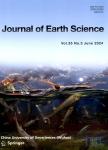Environmental Change and Human Occupation during Late Pleistocene in Hunan Province, South China
作者机构:School of Marine Science, Nanjing University of Information Science and Technology Hunan Institute of Archaeology Institute of Scientific and Technical History, Nanjing University of Information Science and Technology College of Urban and Environmental Sciences, Peking University
出 版 物:《Journal of Earth Science》 (地球科学学刊)
年 卷 期:2024年
核心收录:
学科分类:070905[理学-第四纪地质学] 0709[理学-地质学] 07[理学] 0705[理学-地理学] 070501[理学-自然地理学]
基 金:supported by the Zhengzhou Songshan Civilization Research Association Foundation (grant number DZ-7) the National Natural Science Foundation of China (grant number 41771218) the National Key Research and Development Program of China (grant number 2020YFC1521605) the National Social Science Major Foundation of China (grant number 19ZDA231) Natural Science Basic Research Program of Shaanxi Province (grant number 2023-JC-YB-226)
摘 要:The Paleolithic sites in South China have caused controversy regarding human behaviors in response to the rapidly shifting environment of the late Pleistocene. However, chronometric and high-resolution proxies are absent from interpreting the paleoenvironmental evolution. Here we present the chronology, grain size parameters, and geochemical elements records from the Hejialing (HJL) site in South China to reveal the crucial aspects of environmental evolution, and human occupation. The geochemical record shows that during MIS 5e–5a, northern Hunan experienced the influence of summer monsoon and maintained a warm and humid climate. The laterite layer began to develop. During MIS 4, the climate transitioned to dry and cold state, leading to the attraction of hominins to the HJL area due to the abundant water and lithic raw material resources, resulting in their establishment of a short-term camp. The HJL site was primarily inhabited by hunter-gatherer societies within a forested environment. From MIS 4 to MIS 2, Hunan experienced a prolonged period of dry and cold climatic conditions, with a brief rainfall recovery occurring in late MIS 3. Diminished vegetation and resource availability compelled human populations to broaden their activities and undertake migrations. The HJL site was abandoned amid the arid phase of MIS 2. The HJL area gradually became buried beneath eolian dust deposition (EM1) from distant sources and riverine dust from nearby sources (EM2), and the site was informed. In MIS 1, During MIS 1, the climate shifted to a warm and humid state, marking the emergence of early agricultural practices. As an essential part of South China, the environmental evolution process and diverse survival strategies employed by hominins in Hunan are vital for explaining how the paleoenvironment drove human occupation during the Late Pleistocene.



